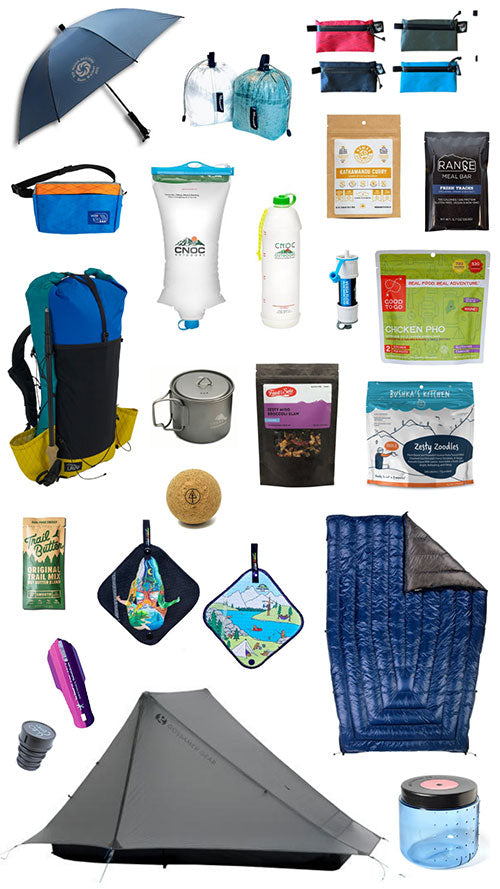
If you’ve ever woken up in a literal puddle while on a backcountry adventure, you know just how important it is to pick the perfect campsite. Just because that view is stunning or it has the best bear-hanging tree around doesn’t necessarily mean it checks all the boxes for what makes a night on trail comfortable and low-impact.
But don’t worry, with a few thousand miles of trial-and-error under my belt, I’m here to make sure you lay your head somewhere comfortable and safe for the night (well, as comfortable as your inflatable ultralight pillow can be).
This article will have quite a bit of overlap with the principles of Leave No Trace. With thru-hiking and backpacking rising in popularity, it’s important now more than ever that everyone does their part to properly care for our public lands.
Between safety, practicing proper trail ethics, and maximizing comfort, there are plenty of factors to consider before you put stakes in the ground. Here are the most important ones I always go through when deciding on a spot to call home for the night:
1. Don’t Camp Too Close to Water

I learned this advice the hard way ... jolting awake on the Colorado Trail to a magnificent SPLASH as a large, still unknown animal ran past my camp and into a nearby stream that I realize now was a bit too close for comfort. Aim for setting up camp at least 200 feet from water sources (about 70 adult steps) to decrease the likelihood of any animals wandering into your camp during the night, and also to ensure you don’t contaminate water sources.
2. Anticipate Bad Weather

Scanning a potential campsite for hazards goes hand-in-hand with proper lightning safety. To make sure you’re not increasing your risk of a lightning strike, avoid tall, isolated trees as well as high-altitude exposed areas. If you’re expecting a storm to roll through overnight, spread out your group, and seek out a depression or valley below treeline. Whether you’re expecting a storm or not, make sure you scan the treetops for any broken branches that may be dislodged by strong winds. For more information about lightning safety, check out The DOs and DONTs of Lightning Safety in the Backcountry.
3. Look for Durable Ground

Durable ground can mean lots of things, but what is most important is leaving as little impact as possible when you choose your site. A high-impact site that has already been established is going to be your best option, but any spot that either naturally lacks vegetation (such as exposed rock or sandy beaches) or has already had noticeable impact from campers is a good alternative. The goal is to keep leftover traces from your night under the stars as confined as possible, as well as decrease the likelihood of waking up in a puddle.
4. Follow Local Guidelines and Regulations

It’s not uncommon for thru-hikes to take you through a number of areas with unique rules and regulations related to camping. State and national parks will often require permits in advance and have restrictions on camping close to roads and buildings, and sometimes even require hikers to camp only in designated sites. Guidelines may change depending on the time of year. Plan ahead and make sure that you know what is expected of backpackers before you begin your trek (because no one wants a ranger knocking on their tent at 4 am).
5. Consider Downloading a Navigation App

Apps such as Guthook, Gaia GPS and All Trails have become increasingly popular in the thru-hiking community, and one of their biggest advantages (besides the fact that it doesn’t add a single ounce to your base weight) is that you can see comments from other users that have come before you. For campsites, this means you’ll know whether that water source is really flowing, if there’s a problem bear in the area, or whether a site pools up during rain storms. You can also indulge your inner trail angel and leave comments and advice for thru-hikers that follow in your footsteps (but be sure to keep an eye on battery life!)
6. Set Up on Level Ground

This may be self-explanatory, but it is nonetheless essential in picking a solid place to camp. Sliding to the bottom of (or out of) your shelter at night is unpleasant, simply stated.
What do you look for in the perfect campsite? Can you think of anything else to add to the list? Drop your ideas in the comments below!














1 comment
Kim Kremer
I’m a hammock camper. One of the advantages of sleeping in a hammock is the only impact on the area is your footfalls. (This assumes you’re using appropriate straps.) You don’t need a clear, flat spot. You need trees, but sleeping on the ground is still an option if you cannot find trees.